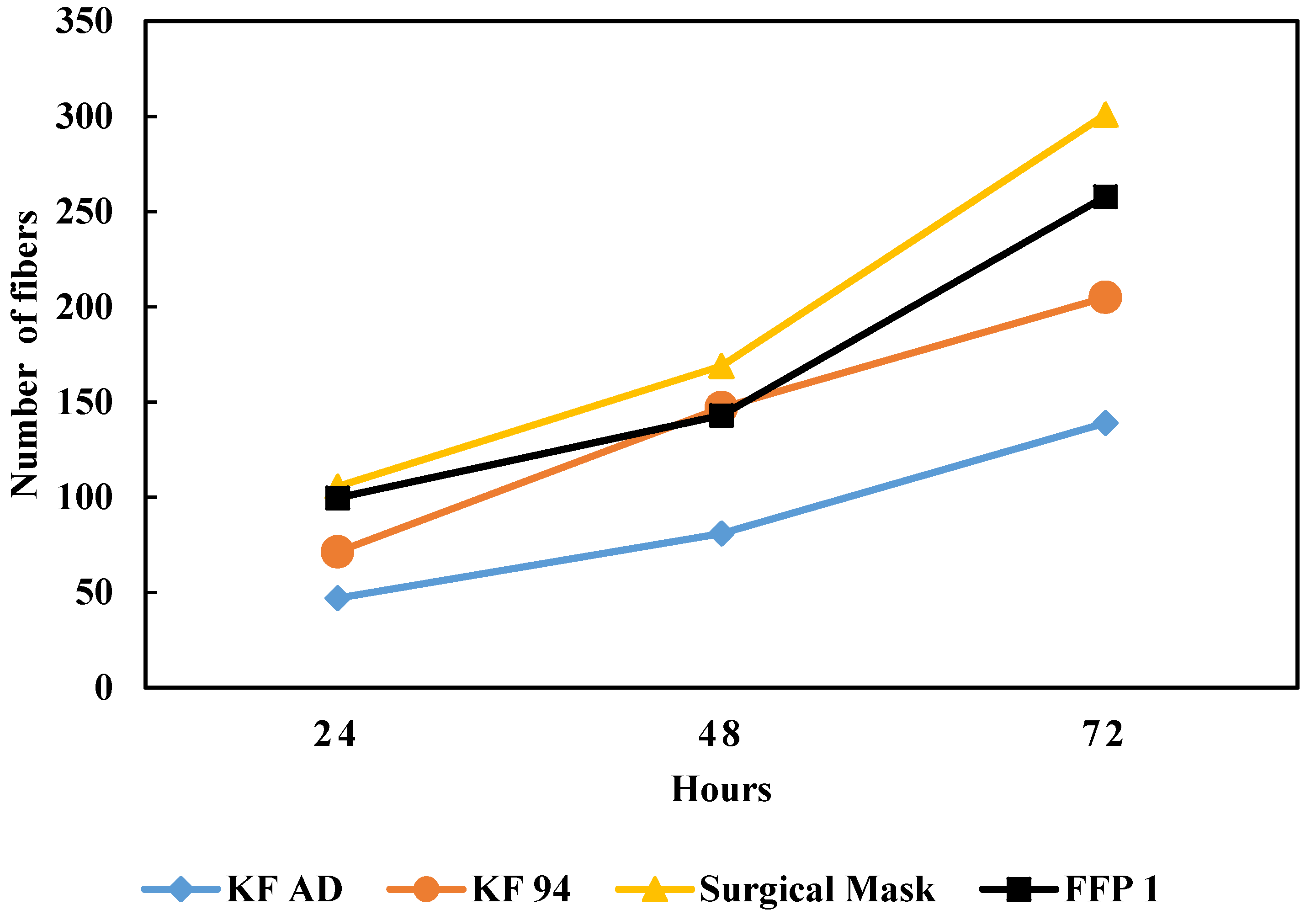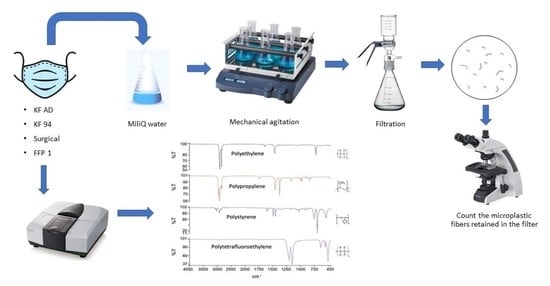Facemasks: A Looming Microplastic Crisis
Abstract
:1. Introduction
2. Methodology
2.1. Identification Quantification of Released Microplastic Fibers
2.2. Calculation of Total Number of Released Microplastic Fibers
3. Results
3.1. FTIR Spectral Analysis
3.2. Microplastic Fiber Count
3.3. Variation of Number of Released Microplastic Fibers over Time
3.4. Impact on Tertiary Environments
4. Discussion
5. Conclusions
Supplementary Materials
Author Contributions
Funding
Institutional Review Board Statement
Informed Consent Statement
Data Availability Statement
Acknowledgments
Conflicts of Interest
References
- Gorrasi, G.; Sorrentino, A.; Lichtfouse, E. Back to plastic pollution in COVID times. Environ. Chem. Lett. 2020, 19, 1–4. [Google Scholar] [CrossRef]
- Davies, N.G.; Kucharski, A.J.; Eggo, R.M.; Gimma, A.; Edmunds, W.J.; Jombart, T.; O’Reilly, K.; Endo, A.; Hellewell, J.; Nightingale, E.S.; et al. Effects of non-pharmaceutical interventions on COVID-19 cases, deaths, and demand for hospital services in the UK: A modelling study. Lancet Public Health 2020, 5, e375–e385. [Google Scholar] [CrossRef]
- De-la-Torre, G.E.; Aragaw, T.A. What we need to know about PPE associated with the COVID-19 pandemic in the marine environment. Mar. Pollut. Bull. 2021, 163, 111879. [Google Scholar] [CrossRef] [PubMed]
- Aragaw, T.A. Surgical face masks as a potential source for microplastic pollution in the COVID-19 scenario. Mar. Pollut. Bull. 2020, 159, 111517. [Google Scholar] [CrossRef]
- Tareq, M.S.; Rahman, T.; Hossain, M.; Dorrington, P. Additive manufacturing and the COVID-19 challenges: An in-depth study. J. Manuf. Syst. 2021, in press. [Google Scholar] [CrossRef] [PubMed]
- Galloway, T.S.; Cole, M.; Lewis, C. Interactions of microplastic debris throughout the marine ecosystem. Nat. Ecol. Evol. 2017, 1, 116. [Google Scholar] [CrossRef]
- Taylor, M.L.; Gwinnett, C.; Robinson, L.F.; Woodall, L.C. Plastic microfibre ingestion by deep-sea organisms. Sci. Rep. 2016, 6, 33997. [Google Scholar] [CrossRef] [Green Version]
- Saliu, F.; Veronelli, M.; Raguso, C.; Barana, D.; Galli, P.; Lasagni, M. The release process of microfibers: From surgical face masks into the marine environment. Environ. Adv. 2021, 4. [Google Scholar] [CrossRef]
- De Falco, F.; Gullo, M.P.; Gentile, G.; Di Pace, E.; Cocca, M.; Gelabert, L.; Brouta-Agnesa, M.; Rovira, A.; Escudero, R.; Villalba, R.; et al. Evaluation of microplastic release caused by textile washing processes of synthetic fabrics. Environ. Pollut. 2018, 236, 916–925. [Google Scholar] [CrossRef]
- Nzediegwu, C.; Chang, S.X. Improper solid waste management increases potential for COVID-19 spread in developing countries. Resour. Conserv. Recycl. 2020, 161, 104947. [Google Scholar] [CrossRef]
- Worldmeter. Available online: https://www.worldometers.info/world-population/south-korea-population/ (accessed on 1 June 2021).
- Diao, Z.; Wang, L.; Yu, P.; Feng, H.; Zhao, L.; Zhou, W.; Fu, H. Super-stable non-woven fabric-based membrane as a high-efficiency oil/water separator in full pH range. RSC Adv. 2017, 7, 19764–19770. [Google Scholar] [CrossRef] [Green Version]
- Zhang, W.; Shi, Z.; Zhang, F.; Liu, X.; Jin, J.; Jiang, L. Superhydrophobic and superoleophilic PVDF membranes for effective separation of water-in-oil emulsions with high flux. Adv. Mater. 2013, 25, 2071–2076. [Google Scholar] [CrossRef]
- Potluri, P.; Needham, P. Technical textiles for protection. Text. Prot. 2005, 151–175. [Google Scholar] [CrossRef]
- Liebsch, T. The Rise of the Face Mask: What’s the Environmental Impact of 17 Million N95 Masks? Available online: https://ecochain.com/knowledge/footprint-face-masks-comparison/ (accessed on 1 June 2021).
- Jang, E.S.; Kang, C.W. Do Face Masks become Worthless after Only One Use in the COVID-19 Pandemic? Infect. Chemother. 2020, 52, 583–591. [Google Scholar] [CrossRef]
- Fadare, O.O.; Okoffo, E.D. Covid-19 face masks: A potential source of microplastic fibers in the environment. Sci. Total Environ. 2020, 737, 140279. [Google Scholar] [CrossRef]
- Prata, J.C.; Silva, A.L.P.; Walker, T.R.; Duarte, A.C.; Rocha-Santos, T. COVID-19 Pandemic Repercussions on the Use and Management of Plastics. Environ. Sci. Technol. 2020, 54, 7760–7765. [Google Scholar] [CrossRef] [PubMed]
- Bondaroff, T.P.; Cooke, S. Masks on the Beach: The Impact of COVID-19 on Marine Plastic Pollution. Oceansasia 2020. Available online: https://oceansasia.org/wp-content/uploads/2020/12/Marine-Plastic-Pollution-FINAL-1.pdf (accessed on 29 June 2021).
- Wu, P.; Huang, J.; Zheng, Y.; Yang, Y.; Zhang, Y.; He, F.; Chen, H.; Quan, G.; Yan, J.; Li, T.; et al. Environmental occurrences, fate, and impacts of microplastics. Ecotoxicol. Environ. Saf. 2019, 184, 109612. [Google Scholar] [CrossRef]
- Kirstein, I.V.; Kirmizi, S.; Wichels, A.; Garin-Fernandez, A.; Erler, R.; Loder, M.; Gerdts, G. Dangerous hitchhikers? Evidence for potentially pathogenic Vibrio spp. on microplastic particles. Mar. Environ. Res. 2016, 120, 1–8. [Google Scholar] [CrossRef] [Green Version]
- Neto, J.A.B.; Gaylarde, C.; Beech, I.; Bastos, A.C.; da Silva Quaresma, V.; de Carvalho, D.G. Microplastics and attached microorganisms in sediments of the Vitória bay estuarine system in SE Brazil. Ocean. Coast. Manag. 2019, 169, 247–253. [Google Scholar] [CrossRef]
- Zhou, Y.; Wang, J.; Zou, M.; Jia, Z.; Zhou, S.; Li, Y. Microplastics in soils: A review of methods, occurrence, fate, transport, ecological and environmental risks. Sci. Total Environ. 2020, 748, 141368. [Google Scholar] [CrossRef]
- Zettler, E.R.; Mincer, T.J.; Amaral-Zettler, L.A. Life in the “plastisphere”: Microbial communities on plastic marine debris. Environ. Sci. Technol. 2013, 47, 7137–7146. [Google Scholar] [CrossRef]
- Doremalen, N.; Bushmaker, T.; Morris, D. Aerosol and Surface Stability of SARS-CoV-2 as Compared with SARS-CoV-1. N. Eng. J. Med. 2020, 382, 1564–1567. [Google Scholar] [CrossRef]
- De-la-Torre, G.E. Microplastics: An emerging threat to food security and human health. J. Food Sci. Technol. 2020, 57, 1601–1608. [Google Scholar] [CrossRef] [PubMed]
- Horton, A.A.; Walton, A.; Spurgeon, D.J.; Lahive, E.; Svendsen, C. Microplastics in freshwater and terrestrial environments: Evaluating the current understanding to identify the knowledge gaps and future research priorities. Sci. Total Environ. 2017, 586, 127–141. [Google Scholar] [CrossRef] [Green Version]
- Hurley, R.R.; Nizzetto, L. Fate and occurrence of micro(nano)plastics in soils: Knowledge gaps and possible risks. Curr. Opin. Environ. Sci. Health 2018, 1, 6–11. [Google Scholar] [CrossRef]
- Choi, S.; Jeon, H.; Jang, M.; Kim, H.; Shin, G.; Koo, J.M.; Lee, M.; Sung, H.K.; Eom, Y.; Yang, H.S.; et al. Biodegradable, Efficient, and Breathable Multi-Use Face Mask Filter. Adv. Sci. 2021, 8, 2003155. [Google Scholar] [CrossRef] [PubMed]





| β | Number of Masks (Millions) | Number of Fibers Leached 24 h (Millions) | ||||
|---|---|---|---|---|---|---|
| δ | δ | |||||
| 0.7 | 0.8 | 0.9 | 0.7 | 0.8 | 0.9 | |
| 1 | 29 | 34 | 38 | 1381 | 1578 | 1775 |
| 2 | 59 | 67 | 76 | 2762 | 2536 | 2853 |
| 3 | 88 | 101 | 113 | 4142 | 3805 | 4280 |
| 4 | 118 | 134 | 151 | 5523 | 5073 | 5707 |
Publisher’s Note: MDPI stays neutral with regard to jurisdictional claims in published maps and institutional affiliations. |
© 2021 by the authors. Licensee MDPI, Basel, Switzerland. This article is an open access article distributed under the terms and conditions of the Creative Commons Attribution (CC BY) license (https://creativecommons.org/licenses/by/4.0/).
Share and Cite
Dissanayake, J.; Torres-Quiroz, C.; Mahato, J.; Park, J. Facemasks: A Looming Microplastic Crisis. Int. J. Environ. Res. Public Health 2021, 18, 7068. https://doi.org/10.3390/ijerph18137068
Dissanayake J, Torres-Quiroz C, Mahato J, Park J. Facemasks: A Looming Microplastic Crisis. International Journal of Environmental Research and Public Health. 2021; 18(13):7068. https://doi.org/10.3390/ijerph18137068
Chicago/Turabian StyleDissanayake, Janith, Cecilia Torres-Quiroz, Jyoti Mahato, and Junboum Park. 2021. "Facemasks: A Looming Microplastic Crisis" International Journal of Environmental Research and Public Health 18, no. 13: 7068. https://doi.org/10.3390/ijerph18137068
APA StyleDissanayake, J., Torres-Quiroz, C., Mahato, J., & Park, J. (2021). Facemasks: A Looming Microplastic Crisis. International Journal of Environmental Research and Public Health, 18(13), 7068. https://doi.org/10.3390/ijerph18137068









